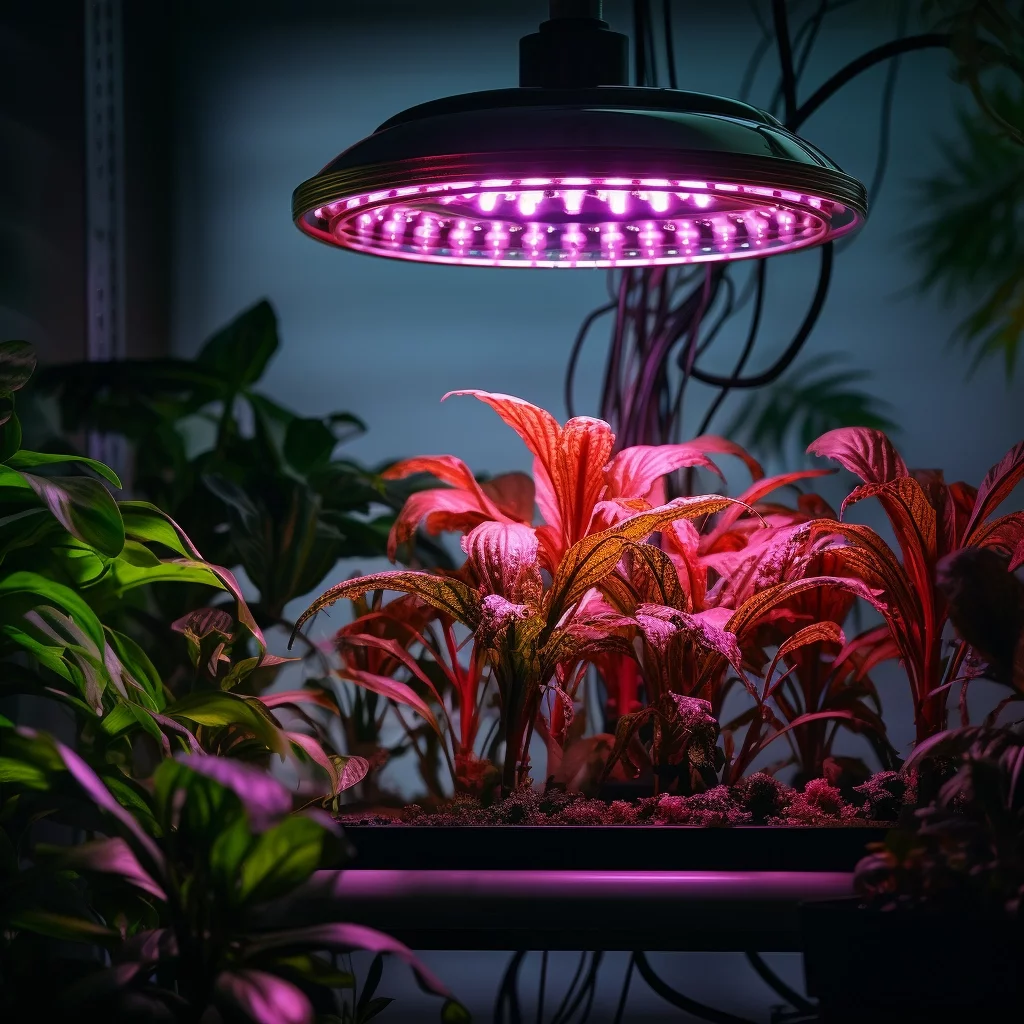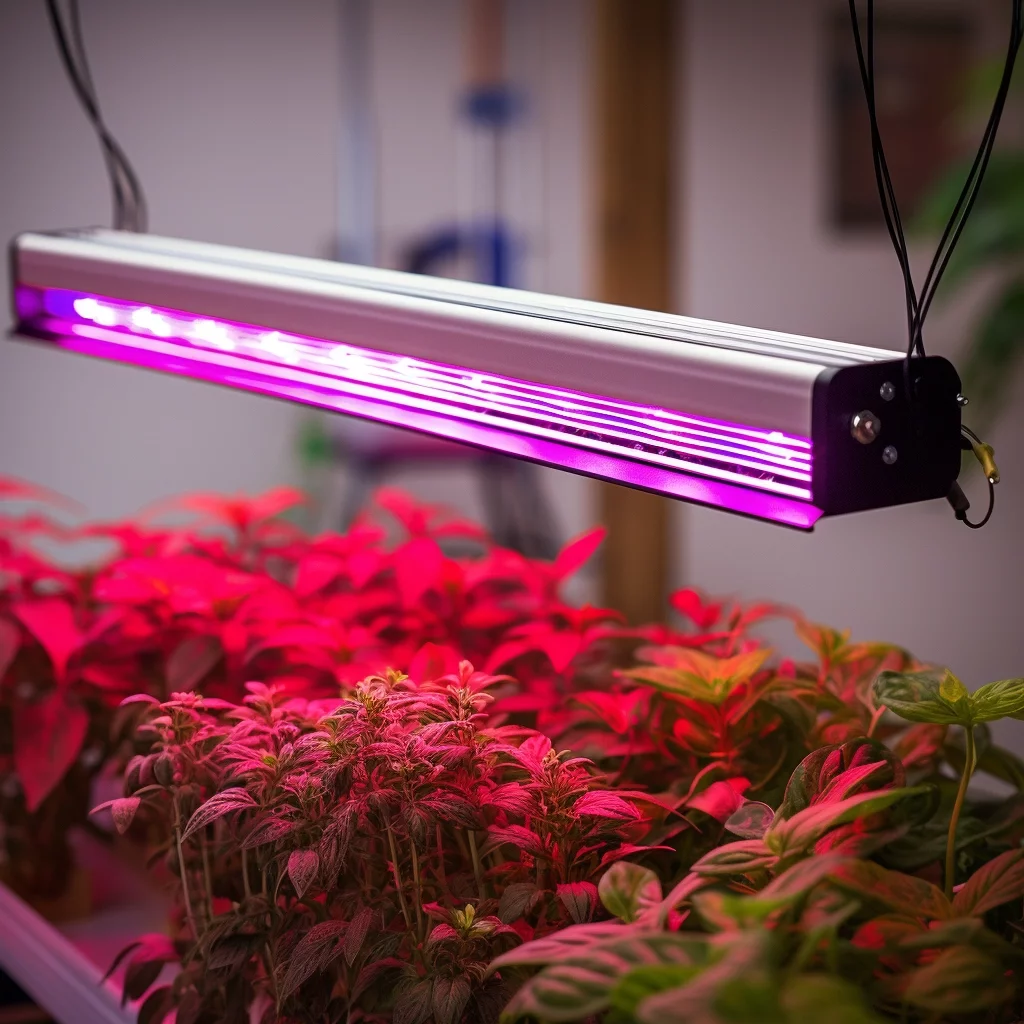As an avid indoor gardener, I’ve delved deep into the world of plant care, particularly focusing on the vital role of lighting. Over time, I’ve gathered a wealth of knowledge about full spectrum LED grow lights and their impact on indoor plant health. Let me walk you through this enlightening journey!

🌱 Adapting to Winter’s Glow: Not All Plants Need Extra Light
It’s a common misconception that all indoor plants require additional lighting during winter. Surprisingly, many plants can adapt to lower light conditions. However, there are tell-tale signs that your green friends might be yearning for more light.
💡 Recognizing the Cry for Light
Signs your plant needs more light include stunted growth, smaller leaves, and elongation as it stretches towards the light source. This is where my trusty lux meter app comes into play. It’s a simple tool on your phone that assesses light levels. For shade-tolerant plants, aim for around 500,000 lux, and for those light-loving ones, 2,000 to 5,000 lux is ideal.
🚨 Plant Placement: A Game of Light and Shadow
Adjusting plant placement can work wonders. Moving plants closer to windows or situating them on east or west-facing windowsills can provide them with that extra light they crave.
🌈 Busting the Myth: The Colorful World of Grow Lights
Not all grow lights bathe your plants in a pink glow. In reality, plants need both red and blue spectrum light for optimal growth. Red light is crucial for flower and fruit development, while blue light strengthens the root system. Modern grow lights smartly combine these spectra, along with others, to offer a full, balanced spectrum.
💡 Quality Matters: The Harmony of Light Spectra
The quality of a grow light hinges on the balance of various spectra. Professional lamps are meticulously designed to cater to plant needs while being easy on human eyes.
😎 Eye Safety and Mood Enhancement with Grow Lights
Grow lights are not just plant-friendly; they’re safe for our eyes too. Moreover, they can help combat seasonal affective disorder by simulating sunlight, uplifting your mood.
🚨 Color Variations in Grow Lights
Grow lights come in various colors, and their effectiveness depends on the combination of red and blue spectra, not just the color of the light.
🌿 Light-Loving vs. Shade-Tolerant Plants
You can distinguish light-loving plants from shade-tolerant ones by observing characteristics like growth speed, leaf color, and density. Typically, succulents fall into the light-loving category.
🌙 Respecting the Natural Light-Dark Cycle
Like us, plants need a night period. Continuous lighting is unnecessary and can disrupt their natural processes. It’s important to adjust the photoperiod, usually between 12 to 14 hours, to mimic natural sunlight conditions.
💡 Grow Light Varieties: From Professional to DIY
Grow lights range from professional, expensive setups to budget-friendly options like simple LED bulbs. Even basic LED lights can effectively support your indoor plants.
☀️ Basic Lighting Needs: The Kelvin Scale
For basic plant lighting, opt for LED bulbs with a color temperature of around 4,000 Kelvin, close to that of sunlight. This is beneficial for plant growth, despite a potential red spectrum deficit.
💪 LED Count Matters
When choosing a grow light, consider the number of LEDs. It determines the power and light output, with more LEDs typically indicating higher wattage.
🌈 The Color Balance in Full-Spectrum Grow Lights
Full-spectrum grow lights include yellow LEDs for white light, silver ones for blue or red light, and occasionally ultraviolet LEDs. The balance of these colors is pivotal for plant growth.
🌱 Budget-Friendly Options: Unl Brand Lamps
Inexpensive options like unl brand lamps can be quite effective in providing supplemental light. Look for those with white light, adequate power coverage, and suitable wattage for your plants’ needs.
🌿 The Critical Distance: Light Intensity and Plant Health
The distance between grow lights and plant leaves is crucial. More powerful lights can be placed farther away, but remember, as distance increases, light effectiveness decreases exponentially. Adjust the distance based on the light’s power.
🌡️ Wattage and Distance: Finding the Sweet Spot
For less powerful lights, keep them closer (around 30 cm). More powerful ones (30W and above) can be situated farther from the plants.
🌱 Heat Considerations: Avoiding Plant Toast
Be wary of excess heat from powerful grow lights. A good rule of thumb is to maintain a distance where you can place your hand under the light without feeling excessive warmth.
☀️ Too Much Light: Watching for Plant Distress
Signs of too much light include leaf curling, scorched edges, or pale spots. If you notice these, adjust the light intensity or distance to protect your plants.
🌿 Variegation and Light: A Delicate Balance
Plants with vibrant variegation, like Tradescantia and Begonia, may lose their patterns under excessive light. It’s essential to find that perfect balance.
💡 Enhancing Plant Well-Being with Grow Lights
While not all plants necessarily require additional light indoors, incorporating grow lights can significantly boost their well-being, especially during those darker winter months.
Incorporating full-spectrum LED grow lights into your indoor gardening routine can transform the health and appearance of your plants. This journey of understanding and adapting lighting for your green companions not only nurtures them but also brings a new level of joy and satisfaction to your indoor gardening experience. Remember, a little light can make a big difference! 🌿☀️💡
FAQ
Are LED lights good for growing plants indoors?
Absolutely! LED lights are highly efficient and effective for growing plants indoors. They are known for their low energy consumption and long lifespan, making them an eco-friendly and cost-effective option. Full spectrum LED grow lights provide a balanced light that mimics natural sunlight, offering the essential wavelengths needed for various stages of plant growth. This makes them suitable for a wide range of indoor plants, including seedlings, flowering plants, and even fruit-bearing plants.
What are the best LED grow lights for indoor plants?
The best LED grow lights for indoor plants are those that offer a full spectrum of light. Some highly recommended options include:
- Phlizon Newest 600W LED Plant Grow Light: Known for its full spectrum and energy efficiency.
- MARS HYDRO TS 1000W Led Grow Light: Offers a sunlike full spectrum and is great for all growth stages.
- VIPARSPECTRA UL Certified 1200W LED Grow Light: Provides balanced coverage and full-spectrum lighting.
- Spider Farmer SF-4000 LED Grow Light: High efficiency with a full spectrum, suitable for larger indoor gardens.
It’s important to choose a grow light based on the specific needs of your plants and the size of your growing area.
How do you use LED grow lights for indoor plants?
To effectively use LED grow lights for indoor plants, follow these guidelines:
- Positioning: Place the lights at the appropriate distance from your plants. This varies based on the light’s intensity but generally ranges from 12 to 30 inches above the plant canopy.
- Timing: Mimic natural sunlight by keeping the lights on for about 12-14 hours a day. Use a timer to regulate the light cycles.
- Adjusting: Monitor your plants’ response and adjust the distance and duration accordingly. Look out for signs of too much or too little light, such as leaf burn or elongation.
- Watering: Plants under grow lights may require more frequent watering, so monitor soil moisture and water as needed.
- Safety: Ensure your grow lights are well-ventilated and not in direct contact with water or excessively humid environments.
Is 6000k good for plants?
A color temperature of 6000K, which falls in the cool white light spectrum, can be good for plants, particularly in their vegetative stage. This cooler spectrum mimics the midday sun and can help promote lush, leafy growth and robust development. However, for a more balanced growth, especially if you’re aiming for flowering or fruiting, it’s advisable to use a full spectrum light that includes both cool and warm wavelengths. Full spectrum lights provide a more comprehensive range for all stages of plant development.
Can full spectrum LED grow lights replace natural sunlight for indoor plants?
Full spectrum LED grow lights can serve as an excellent substitute for natural sunlight, especially in environments where sunlight is scarce or during winter months. These lights provide a range of wavelengths similar to the sun, covering the entire spectrum that plants need for photosynthesis. While natural sunlight is always preferable, full spectrum LEDs are one of the best alternatives available for indoor plant growth.
How long should LED grow lights be on each day for indoor plants?
The duration LED grow lights should be on each day varies depending on the plant species and its growth stage. Generally, most indoor plants thrive with 12 to 14 hours of light per day. Seedlings may benefit from up to 16 hours of light, while flowering and fruiting plants can require 12 to 14 hours. It’s important to mimic the natural day and night cycle to avoid stressing the plants, so incorporating a period of darkness is crucial.
Are LED grow lights expensive to run?
Compared to traditional lighting options like incandescent or fluorescent bulbs, LED grow lights are more energy-efficient and cost-effective in the long run. They consume less electricity and have a longer lifespan, reducing both energy bills and replacement costs. The initial investment in quality LED grow lights is often offset by these long-term savings.
Do LED grow lights emit heat?
LED grow lights emit significantly less heat compared to other types of grow lights like HID (High-Intensity Discharge) or incandescent bulbs. This reduced heat output minimizes the risk of heat damage to plants and allows for closer placement to the plant canopy. However, some heat emission is normal, and adequate ventilation is always recommended to ensure a stable growing environment.
Can I use any LED light as a grow light for plants?
While regular LED lights can support plant growth to some extent, they are not as effective as full spectrum LED grow lights designed specifically for plants. Grow lights provide a balanced spectrum of light, including the critical red and blue wavelengths that regular LEDs might lack. For optimal plant growth, especially for flowering and fruiting, it’s advisable to use a specialized LED grow light.
How do I choose the right size of LED grow light for my indoor garden?
The size of the LED grow light you need depends on the size of your growing area and the type of plants you have. As a general rule, you need about 32 watts of actual power per square foot for high-light plants like tomatoes and 20 watts per square foot for low-light plants like lettuce. Measure your growing area and calculate the wattage required accordingly. It’s also important to consider the light’s penetration depth and coverage area to ensure even light distribution.

